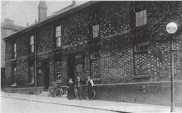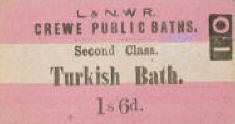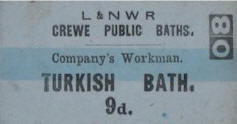Crewe—a company town
In 1865 the population of Crewe was somewhere between twelve and thirteen thousand people, most of whom were railway workers or dependent in some way on the London & North Western Railway Company.1 Almost all the facilities of the town were provided by the company, from houses to cooking facilities for the unmarried, from churches and chapels to schools and public baths.2
The first bathing facilities, comprising slipper baths for men and women, were opened for public use in 1845. They were managed by a subcommittee of the Council of the Mechanics Institute. By 1862, the company had expanded so rapidly that the baths were now right in the middle of the railway works, and access was difficult for workers' wives and for the general public.3
 The company decided, therefore, to build new public baths at the northern end of Mill Lane (later Mill Street) and
these opened in 1866. Built of plain red brick,8
they comprised hot, tepid, and cold baths, showers, and an open-air swimming pool.4 The pool was pretty basic, as was common at that time. Water was changed once per week, and 'the price of admission was reduced as the water became progressively murkier'.5
The company decided, therefore, to build new public baths at the northern end of Mill Lane (later Mill Street) and
these opened in 1866. Built of plain red brick,8
they comprised hot, tepid, and cold baths, showers, and an open-air swimming pool.4 The pool was pretty basic, as was common at that time. Water was changed once per week, and 'the price of admission was reduced as the water became progressively murkier'.5
The Turkish baths
It is not known exactly when the Turkish baths were added, but a letter to the editor of the Crewe Guardian in 1872 suggested that one be added to the baths. So it must have been some time around 1873 as they were included in a local directory dated 1874. Although the swimming pool was open from six till nine on Sunday mornings, and till nine o'clock in the evening during the rest of the week, the Turkish baths were open less often. They were completely closed on Sundays, and for the rest of the week there were two separate sessions each day: from ten to twelve in the morning, and from two till seven in the evening.6
We don't know much about the inside of the Turkish baths, but the entrance tickets were produced using the same machines which printed ordinary travel tickets. The Great Western Railway, in the Turkish baths built for their workers in Swindon, went further: many fittings, eg, door handles and mirrors, were the same as those found in their sleeper carriages.


In 1923, the l & nwr became part of the London, Midland, and Scottish Railway Company. The new company continued to operate the baths for the city for another thirteen years. However, this type of open-air swimming pool was already quite inadequate for a town of the size and importance of Crewe. Elsewhere, bathing facilities were provided by the local authority, and the company understandably saw no reason to expend the large amount of money required to build a modern facility.
In the mid-1930s, Crewe Corporation finally agreed to provide a new bathing establishment. The lms offered to sell the existing baths to the town for £500 but the Corporation, feeling the site was too small, turned down the offer and the new baths were built elsewhere.7
The Mill Street baths closed on 31 March 1936 after serving the town for seventy years. The new establishment was built without Turkish baths.